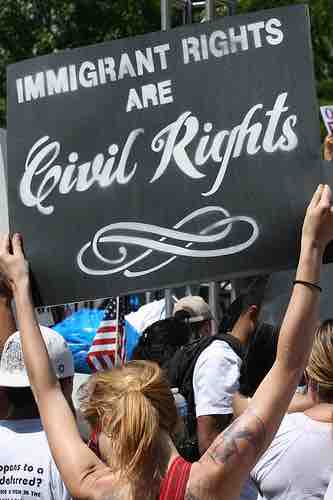Latinos
Latino communities make up one of the fastest growing groups in the US. Latino voters are a diverse group which include long-established Tejano and Californio, Puerto Rican and Chicano voters, as well as the Cuban-American community which makes up a large bloc of voters in Miami. However, recently naturalized citizens from South and Central America, and their children, make up the largest group of Latino voters in the US.
Latino Voting Trends
While Latino voters should not be thought of as a homogenous group, there are still some general trends for the group. On average Latino citizens continue to vote at significantly lower rates that non-Latino white voters.
There are many potential approaches that can be taken to explain variations in voting rates. Institutional approaches look at the ways in which legal documents and organizations shape the ability to vote. Others examine the question of the rationality of voting: does voting serve the self-interest of any given individual, and what are the interests or issues that might change someone's voting patterns? A behavioral approach focuses more on the actions of individuals and groups, taking voting as one part of a larger bundle of political activities.
The US has comparatively low rates of naturalization for immigrant residents. As such, people may live for many years in the US without being able to vote. Additionally, the weaker electoral institutions in the US, including more decentralized election processes and a weaker party system, mean that there are few institutions working to actively incorporate newly naturalized citizens or second generation citizens into the voting process.
Additionally, many Latino political activists, who are more visible in their political participation, have often been quite different from the average Latino. For example, these activists are generally less in need of government supports, and less likely to advocate for such programs. They are, therefore, not good candidates for the type of community organizing that could rally new voters around their own interests.
However, in recent years, a larger number of organizations that serve immigrant and Latino communities have become involved in political participation . These groups are advocating for resources, supports and rights. They are also encouraging the political participation of Latino residents through voter registration drives, and partnerships with other organizations, such as unions, that have traditionally been involved in voter mobilization.

Immigrant Rights and Civil Rights
Organizations serving immigrant communities are starting to encourage more political participation, including voting.
Language Minority Voting Rights
One important institutional change aimed at lowering the cost for Latino voter participation is the Language Minority Provision of the Voting Rights Act, first introduced in 1975, and then amended in 1992 and 2006. This provision is aimed at upholding the principals of the fourteenth and fifteenth amendments to the US constitution, by attempting to eliminate language-based barriers to voting.
This provision has been shown to have a significant impact on improving rates of voting by Latino citizens.